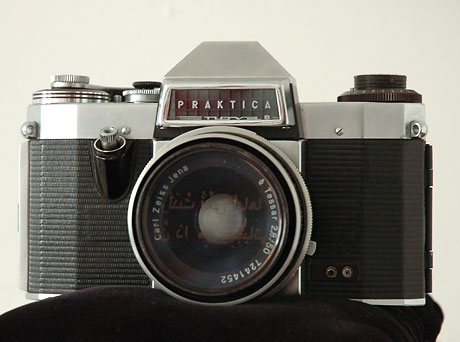
Shezad Dawood
Al-Sabbah Camera, 2009
Vintage Praktica camera with engraved lens, velvet cushion, plinth and framed contact sheet.
Courtesy of the artist and Paradise Row London
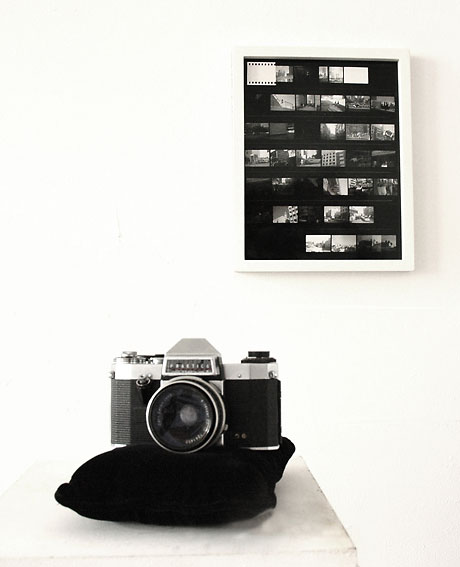
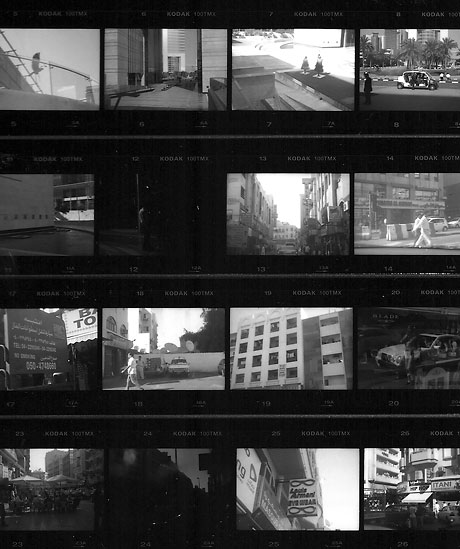
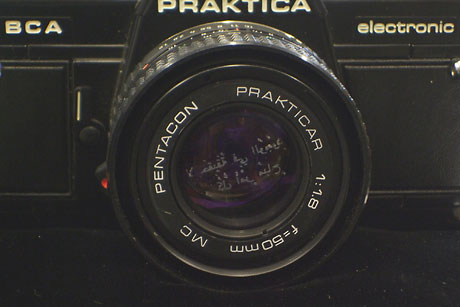
Shezad Dawood
Al-Hallaj Camera, 2009
Vintage Praktica camera with engraved lens, velvet cushion, plinth and framed contact sheet.
Courtesy of the artist and Paradise Row London
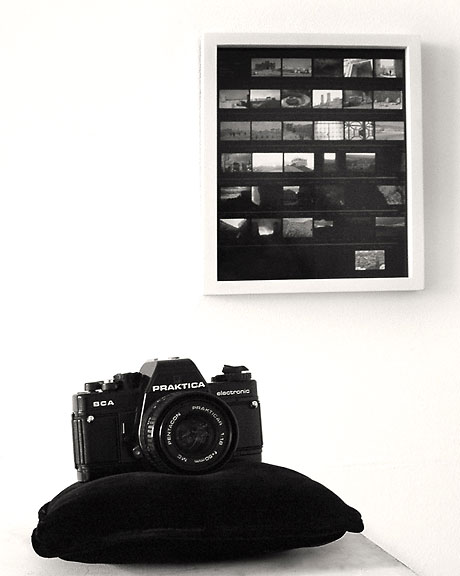
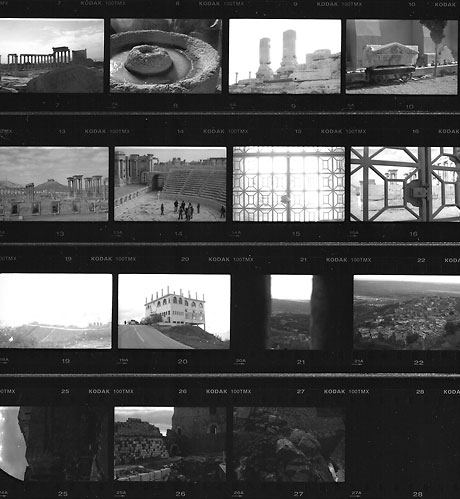
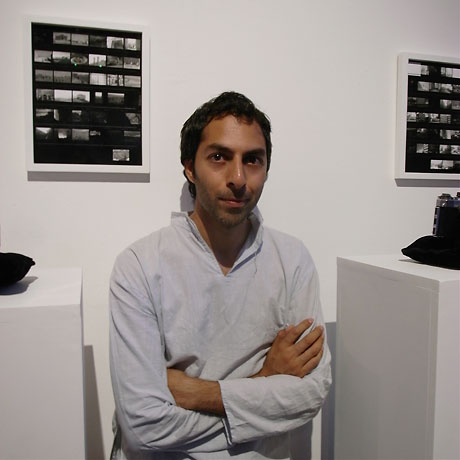
Photography by Sueraya Shaheen
‘Al-Hallaj Camera’ and ‘Al-Sabbah Camera’
October 2009
Based on a conversation conducted between artist Shezad Dawood and Muraqqa editor Alexander Barakat modified into a personal statement exploring Dawood’s two works ‘Al-Hallaj Camera’ and ‘Al-Sabbah Camera’.
The 'Al-Hallaj Camera' and the 'Al-Sabbah Camera' both use iconic phrases by key Islamic mystics - or some might say ‘heretics’ - to look at ideas of perceptual consciousness, in a specific context. I am particularly interested in the way in which perceptual consciousness is discussed as a mode of both initiation and metaphor in Sufism. For example, Rumi says:
'Before my visible Form you flee into the invisible...
But truly my hearth and swelling are in the Invisible...'
(Mathnawi, Book iii, 3706 ff.).
It is interesting to note the capitalisation of ‘Invisible’ in the second line but not in the first, and this parallax is precisely what led me to the camera works. It is essentially the idea of what is hidden and what is revealed, existing in tandem.
The lens of the 'Al-Hallaj Camera' is inscribed with the phrase 'My Mother gave birth to Her Father, What a Rare Marvel Indeed', which is one of the several apocryphal pronouncements of the 9th Century Iranian Sufi mystic Mansur al-Hallaj. His most controversial statement, which led to his execution, was ‘An-Al Haqq (I am the Truth)’, and which uses one of the 99 names of God. While this statement was perceived by his supporters as an abandonment of the self over to God, it was viewed by his detractors as heresy.
One of the reasons for al-Hallaj’s controversial position was his stance on teaching mysticism to the masses, whereas normally it would have only been reserved for the elite. It was the connection between this socialist mysticism and the complex tensions within the Arab world in the aftermath of the colonial period that led me to use the East German 'Praktica' camera in both cases.
What captures my interests in this regard is the very general idea of the tensions between an elite and the masses as embodied in the classical Islamic empires, as much as in the more closed schools of Sufism and other mystic traditions. In that way, one can see very different embodiments of Islamic thought, actually operating within similar structures. With regards to the post-colonial Arab world, part of the movement towards independence in many countries or states was a mass socialist drive, which often identified very strongly with the left. And yet how many former 'colonies' have a popular left government? These connections across time interest me in an oblique manner. The fact of the matter is that even mysticism can and must be examined in light of the social and political structures that surround it. For the 'Al-Hallaj Camera', the images are all shot in both old and new districts of Dubai, and so the phrase contains particular relevance in terms of the amazing speed with which the city has evolved in the desert.
Hassan-i-Sabbah, as many people know, was an 11th Century mystic who founded the assassins from his mountain fortress of Alamut, in what is now modern-day Syria. Sabbah is famous in legend for inducing visions of paradise into his followers in order for them to go out and kill for him. Through the use of hashish and women, his pronouncements have been appropriated and caricatured in many works of Western fiction to a degree that he has almost become the cliché of the intransigent Arab in the west, and is as alive in the contemporary Western imagination as ever. Here I take his most iconic and revolutionary phrase 'Nothing is True, everything is Permitted', later appropriated by such figures as Aleister Crowley and William Burroughs, and the images to accompany this camera are all taken during my travels in contemporary Syria, including Damascus, Palmyra and the crusader castle at Crac-des-Chevaliers.
I was interested in mapping out a multiple layered history of Syria as a site, and like other areas of the 'Middle East', it is rich with many, and varied narratives from the Roman period to the Crusades, taking in some key figures and moments in religious and other history. These layers open up to a vast pluralism and intensity, whether that fits with the contemporary mapping of the Arab world or not. And it is these contradictory facets of the modern Arab world and sectarianism, that interested me in referencing Hassan-i-Sabah for you have this figure who is considered to have practically become a pastiche of Western perceptions of Islamic extremism. Yet theologically, he was actually looking to overturn a number of doctrines of mainstream Islam, and therefore was radical in two respects at once, as both a Nizari Ismaili against what he saw as a more decadent Islam; but also in favour of a more transformative mystical gnosis. As such, he has even been an inspiration to writers and personalities as curious as Nietzsche, Roger Zelazny and Robert Anton Wilson, and nothing is, I suppose quite as simple as it seems.
With regard to the effect the engraving had on the images, and to go back to my opening remarks about perception, typically, as the focal length is too short the phrases in Arabic do not appear on photographs taken with these cameras. The idea being that, as with any mystical truth, somehow it is beyond the field of literal or physical perception. Each camera comes with a contact sheet of film shot through the camera, and what I wished to convey was that somehow rather then merely being imprinted on the literal images shot by the camera, each phrase was somehow transmuted into the aura of the work: the space between the camera, the contact sheet and the viewer somehow pregnant with the possibilities embodied by each phrase.